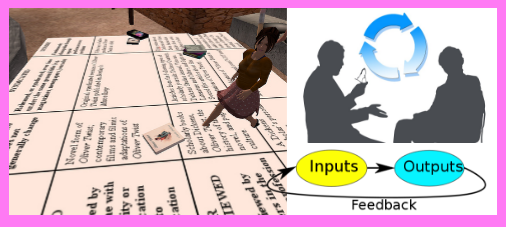


Research on Goal Setting
- Goal settting – setting a direction for learning
- 3 Research Generalizations
- Instructional goals narrow what to focus on
- need to be careful about what goals students focus on because this focusing effect can lead them to ignore important info
- Instructional goals should not be too specific
- Effective objectives have 3 characteristics
- performance – what learning should be able to do when goal is met
- conditions – context for performance
- criterion – specific descriptions of meeting performance standards
- Caveat – objectives that meet 3 criteria may be too specific to accommodate individual learning
- Effective objectives have 3 characteristics
- Students should be encouraged to personalize teacher’s goals
- Setting goals in contractual setting – students set goals and contract grade they will get for meeting those goals
- Instructional goals narrow what to focus on
Classroom Tips related to Goal Setting:
- Provide general learning goals and have students develop related personal goals from these
- Classroom contracts – base grades on students’ ability to set and meet personal academic goals / timelines
Research on Providing Feedback
- Feedback should be corrective in nature – i.e. provide specific feedback on what’s correct (and not)
- providing students with correct answers doesn’t seem to improve performance
- need to provide related explanations to correct answers to improve performance
- keeping students working on task until they get it right seems to improve achievement
- Feedback should be timely
- the greater the delay in feedback, the less positive impact on performance
- giving tests one day after learning experience seems to be optimal
- feedback immediately after test-like activity appears to enhance performance
- Feedback should be specific to criterion
- Norm-based feedback compares student performance to other students’ performance. This is not effective
- Criterion-based feedback compares student performance to academic criteria. This is more effective than norm-based feedback.
- Students can effectively provide some feedback
- Students can track own learning and get good results.
Classroom Tips related to Feedback:
- Criterion referenced feedback
- Use rubrics that show different levels of knowledge and skills
- Feedback on specific types of knowledge and skill
- when possible try to focus feedback on specific learning targets
- cumulative letter grades do not provide enough information to improve performance
- Student-led feedback
- Student led feedback can improve achievement. See this article for ideas on how to scaffold good descriptive feedback.

Project baed learning (PBL) can offer many opportunities for students to set personal goals. One way to achieve this is to launch projects with broad provocative essential questions (driving questions) that students can personalize for their own projects. Another way to do this is to gives students voice and choice over the format of their products. One extreme example of this is multigenre projects.
Throughout the project, timely corrective feedback is key to supporting students’ success. Providing timely feedback on work days can help students improve their understanding and their products. Providing timely feedback during scaffolding activities and immediately after assessments can help students improve their knowledge and skills.

Preparation Steps
- Decide what strategies and tools you will use to support student goal setting.
- Decide what strategies and tools you will use to provide timely feedback.
- Design rubrics with descriptive, leveled criteria that can help provide efficient, timely descriptive feedback.
- Use technology such as Nearpod, Socrative, etc. that can be used to give students timely feedback on assessments.
Early Implementation Steps
- Set aside class time for students to set and track their goals and reflect on the strategies they are using (or not using) to achieve their goals
- Set aside time for team meetings during work days to give students specific feedback based on the rubric on their products. Have students clarify and summarize feedback and plan next steps at the meetings.
Advanced Implementation Steps
- Engage students in tracking their progress towards long term skills / academic goals.
- Use advanced techniques such as standards based grading to give students specific feedback over time.

